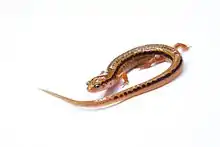Blue Ridge two-lined salamander
The Blue Ridge two-lined salamander (Eurycea wilderae) is a species of salamander in the family Plethodontidae, endemic to the United States. Its natural habitats are temperate forests, rivers, intermittent rivers, and freshwater springs. It is threatened by habitat loss.
| Blue Ridge two-lined salamander | |
|---|---|
 | |
| Scientific classification | |
| Kingdom: | Animalia |
| Phylum: | Chordata |
| Class: | Amphibia |
| Order: | Urodela |
| Family: | Plethodontidae |
| Genus: | Eurycea |
| Species: | E. wilderae |
| Binomial name | |
| Eurycea wilderae Dunn, 1920 | |
The Blue Ridge two-lined salamander is found in the southern Appalachian Mountains, mostly south of Virginia. To the north is a similar salamander, Eurycea bislineata, or the northern two-lined salamander. Adult Blue Ridge two-lined salamanders are commonly found near stream banks. The larvae are aquatic, living in streams and seeps.
The species is named after zoologist Inez Whipple Wilder, who studied biology of Eurycea species.[1] These amphibians are listed by the IUCN as a species of least concern for conservation.
References
- Dodd, C. Kenneth (2004). The Amphibians of Great Smoky Mountains National Park. University of Tennessee Press. p. 161. ISBN 978-1-57233-275-1.
- Hammerson, G. 2004. Eurycea wilderae. 2006 IUCN Red List of Threatened Species. Downloaded on 23 July 2007.
